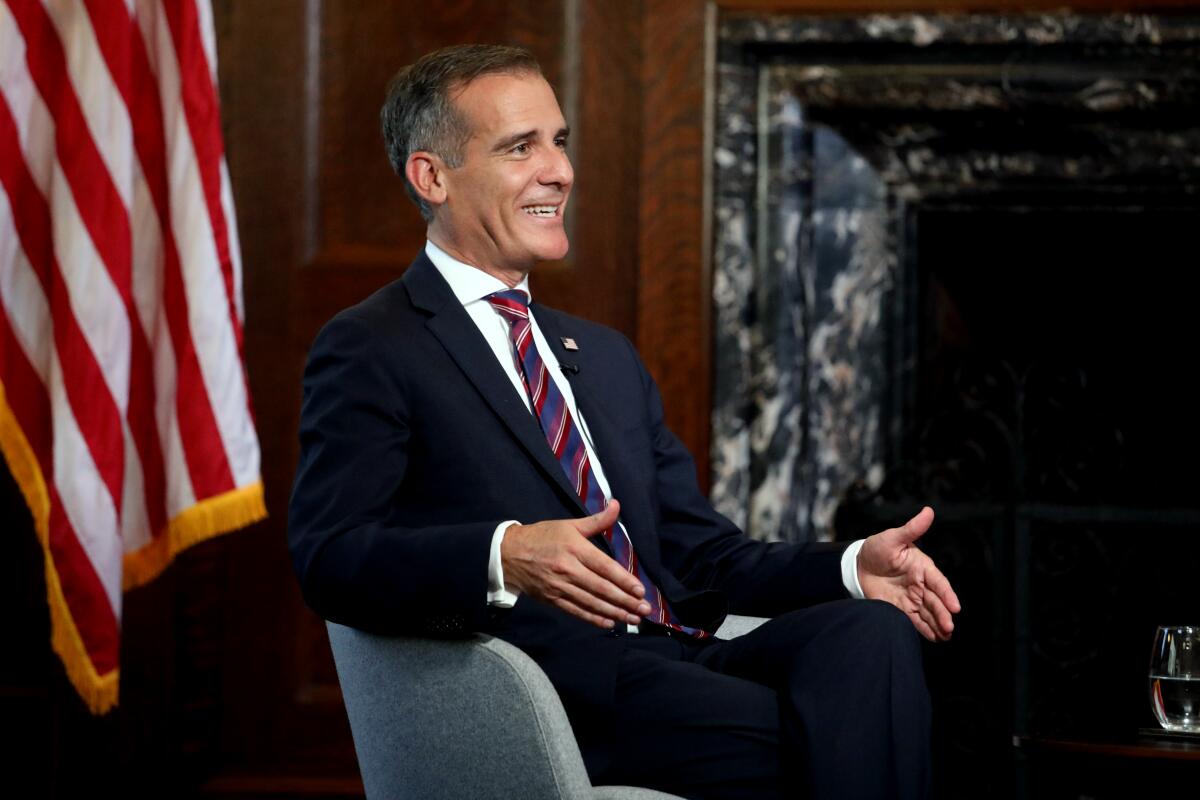Where is America’s missing ambassador to India?

- Share via
The recent decision by President Biden’s administration to renominate former Los Angeles mayor Eric Garcetti to be U.S. ambassador to India has highlighted the peculiar state of the bilateral relationship.
Since Biden took office two years ago, the United States has not had an ambassador in New Delhi – and this at a time when the U.S. is assiduously courting India as a potential counterweight to China in the Indo-Pacific. Together with Australia, Japan and the U.S., India is essential to maintaining the balance of power in the region. And as a member of the fledgling I2U2 partnership, which also includes Israel, the United Arab Emirates, and the U.S., India has a crucial role to play in containing Chinese influence in the Middle East.
Given India’s strategic importance, why has the White House left the ambassador position vacant for two years? The answer has nothing to do with India. Garcetti was nominated in July 2021, a few months into the new administration. But his Senate confirmation ran into trouble over allegations that as mayor he ignored sexual harassment complaints against one of his aides.
Indian officials, initially nonplussed, became irritated. Over the past 20 months, several American envoys served as chargé d’affaires at the New Delhi embassy, but they were all transferred and replaced before they could establish the local relationships vital to their success. Recently, career diplomat Elizabeth Jones was named to the post. But her appointment is temporary, too, and she is expected to step down once a full-time ambassador is confirmed.
Biden has called the U.S.-India partnership “one of the most important relationships we have” and hailed the country as an “indispensable” partner. But the administration’s inability to name an ambassador has led some Indians to wonder whether the administration would have left the same post in London or Paris vacant for so long.
Meanwhile, the strategic relationship between the U.S. and India has never been more crucial. For years, India resisted pressures to take sides in America’s escalating rivalry with China. But China’s recent encroachments on Indian territory in the Himalayas have caused India to challenge Chinese expansionism. In addition to this shared concern, India seeks U.S. cooperation on security, technology, and climate change.
India is also an important economic partner. The U.S. is one of the subcontinent’s biggest sources of foreign direct investment, with annual FDI standing at $45 billion in 2021. Unnerved by China’s dominance over global supply chains, American officials have been encouraging U.S. companies to establish manufacturing bases elsewhere, placing India at the center of the administration’s “friend-shoring” agenda. Apple, for example, is expected to produce roughly 25% of its iPhones in India by 2025. Similarly, the Indian pharmaceutical industry is capable of replacing China as America’s main supplier of common generic medications.
But the failure to confirm Garcetti has undermined this mutually beneficial relationship. His confirmation struggles aside, Garcetti is a good choice for the post. He is young and energetic, and his close relationship with Biden suggests that he would enjoy direct access to the president.
Having a U.S. ambassador who has the president’s ear is advantageous for the host country. Roosevelt House, as the ambassador’s residence in New Delhi is called, has been occupied by colorful figures like the economist John Kenneth Galbraith, who famously went straight to his close friend President Kennedy whenever he wanted to bypass State Department bureaucracy, including during the Sino-Indian War. Daniel Patrick Moynihan also occupied the post, before becoming a U.S. senator.
While White House officials privately blame the Senate confirmation process for the absence of a permanent ambassador, the question remains: If India matters as much as the U.S. says it does, why has the administration not acted more forcefully to get its nominee confirmed?
The irony is that strengthening U.S.-India relations is one of the rare foreign policies with bipartisan support in Washington. Since President Clinton’s historic visit in 2000, both Republican and Democratic administrations have treated India as an essential partner in America’s geopolitical strategy.
India, which assumed the presidency of the G20 in December, fits well into America’s global vision, and the two countries have much to gain from cooperating on common concerns such as climate change and Islamic terrorism. While they seem to disagree on how to contain China’s rise, that is all the more reason to ensure that the mechanisms of diplomacy are functioning properly.
It is time for the Biden administration to get its act together and put Garcetti on a plane to New Delhi without further delay.
Shashi Tharoor, a former United Nations undersecretary-general and former Indian minister of state for external affairs and minister of state for human resource development, is a member of parliament for the Indian National Congress.
More to Read
A cure for the common opinion
Get thought-provoking perspectives with our weekly newsletter.
You may occasionally receive promotional content from the Los Angeles Times.









